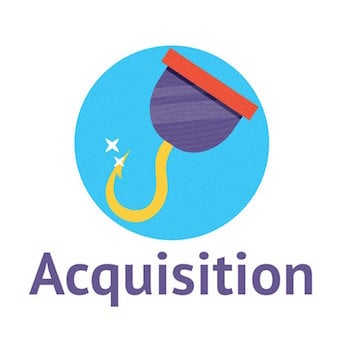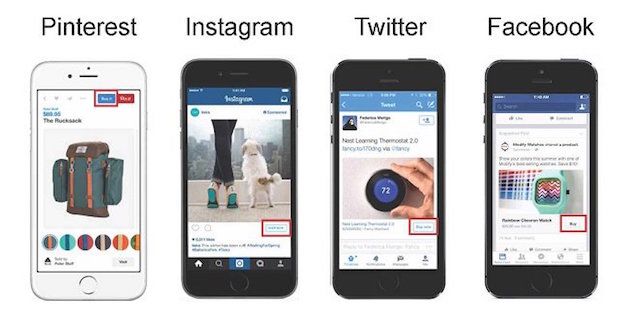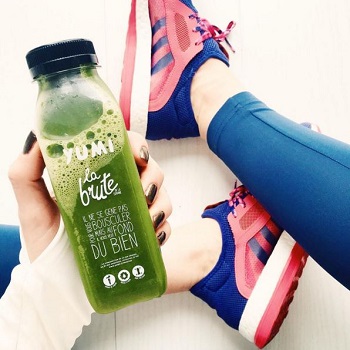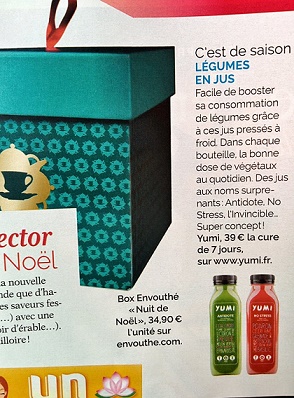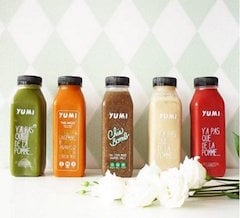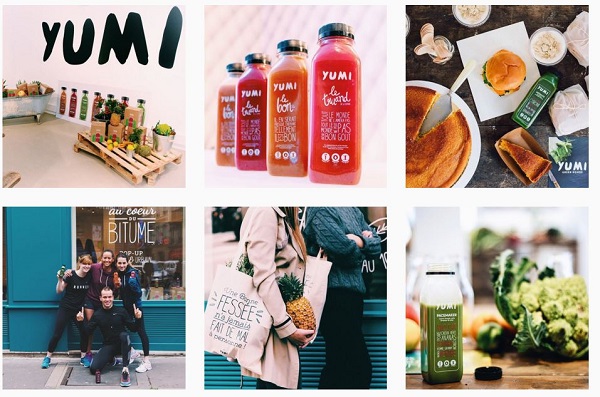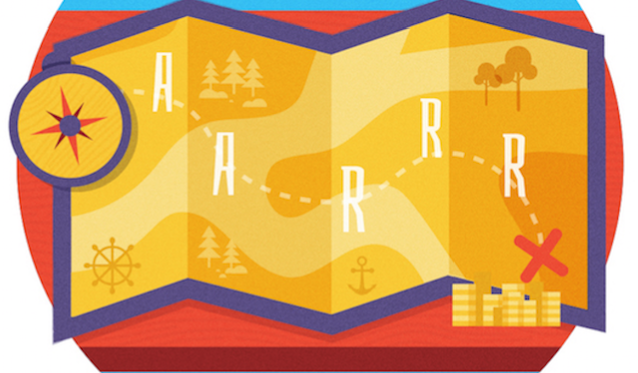
Acquisition: AARRR Metrics Part 1
We’re starting a series of articles on the popular framework of metrics created by Dave McClure called AARRR Metrics or Pirate Metrics (watch his presentation of the AARRR metrics concept).
The name imitates pirate talk and is an acronym for the five essential metrics an eCommerce should keep an eye on: acquisition, activation, retention, referral, revenue.
For an overview of all five, check out our article, AARRR Metrics For eCommerce Stores: The Holy Grail of Growth.
In the series, we’re going to talk about each metric, what’s most important to have in mind about them and some simple steps to try and improve your business’ score.
Since the series will focus on essentials and simple beginner steps, it’s most suitable for e-commerce entrepreneurs who don’t fancy themselves experts, but rather keep asking, “How can I start selling more?”. The AARRR framework is designed with the end goal to increase revenue, so bear with us.
ACQUISITION: Get customers in
The first pirate metric we’re exploring is acquisition – the first in the AARRR funnel. We often forget the simplest things – if you want to get noticed and acquire new customers, you should put yourself forward. No matter how great your product is, people need to learn about it.
Why is Acquisition important for Ecommerce?
Naturally – no customers, no business. It’s how effectively you bring people to visiting your e-commerce site. Those are the people you get in the funnel and start selling to.
Your user experience, product, reviews, prices, offers – everything – comes after you acquire those people. That’s why it’s important to get the right people in, not just many of them.
Of course, the more, the better, but they should also be qualified leads. Chances are, you don’t need hundreds of thousands of new visitors, but rather a few matching your target customer profile. You know I’m right.
How to measure Acquisition?
While volume matters, quality of leads is essential. You’ll be measuring how many people you acquire in a given period and from certain channels. You’ll also have to measure how many of them convert to customers.
That’s why acquisition is usually broken down by channels – to see which ones perform best in terms of price, quality and volume. The best acquisition channel sits at the intersection of all three.
For this purpose, it’s essential to know where they come to you from – these are your acquisition channels. After initial testing, eliminate all channels that don’t work and spend your marketing budget and effort on the few that do work.
Try Metrilo for free
eCommerce analytics that help you drive growth
Acquisition channels in ecommerce:
- Social Networks
- SEM
- SEO
- PR (unconventional PR/ Publicity)
- Email Marketing
- Campaigns, Contests
- Affiliates and Affiliate Programs
- Review sites
- Targeting blogs
- Social and Display Ads
- Offline Ads
- Offline Events
We’re going to focus on the main and proven channels here that are great for eCommerce businesses to start off with.
Social Networks as an Acquisition Channel
Like it or not, social networks are a main source of information for most people so if you are not active there, get to work.
To start with, figure out where your target audience hangs out – trust me, it’s not everywhere. Do a little stalking on your best customers or people who match your target customer profile – what networks they are on, what they share there and how they interact.
Then give potential customers the chance to hear about you – and use the medium they prefer. This means both brand presence and advertising.
Don’t start selling right away. Build your social presence around giving potential leads some interesting information so they engage with you. This can be (and often is) done through a non-branded fan page/ profile on social media. Resources, inspiration, news, tips, events….
Think a Runners for life fan page, Instagram profile, etc., where you talk about all aspects of jogging but you don’t push your products. That will be the basis for your runner gear shop community.
Once you achieve that status, keep it up. Be much more than an online retailer. Be part of their newsfeed and their life, be a friend sharing a laugh with them (even though it’s online), educate them, inform them, and most importantly – make them forget you have products to sell. Just be there for them when they need to buy. They’ll think of you first.
This way acquisition channel allows you to build a brand image that only attracts qualified leads.
Facebook Key Highlights:
- Facebook is the most popular with about 85% of all e-commerce orders coming via social media.
- It has the highest conversion rate in e-commerce among social media, 1,85%.
- E-commerce business who sell photography products, pet supplies, sports gear, jewelry, clothing, food, and beauty products get the largest chunk of their sales through Facebook (81-98% of all social media acquisitions).
Since this is an overview of how you a beginner can turn around your Facebook acquisition, here are a few examples of what brands can do on social media to build community and drive engagement.
Twitter Key Highlights:
- 53% of people who tweet at a brand expect a response within an hour. If they’re complaining, 72% would expect that fast of a response. So make sure you provide outstanding customer support via Twitter – you’ll be making a good impression. (see more stats on Twitter user behavior)
- Best for engaging during an event because of event hashtags – both attendees and outsiders.
- 49% of monthly users follow brands or companies. For social networks in general that is 16%. This makes Twitter the top platform for people to see updates from brands.
- A “Buy” button is available to eCommerce businesses on Twitter. Here is a guide how to set it up and increase acquisition right from the platform.
Pinterest Key Highlights:
- The visual nature of the platform makes it a great tool for providing useful information (tutorials, matching charts, choosing guides, etc.) and lifestyle associated with your products. It’s a truly great platform to create your brand image out of beautiful images that speak to your target audience.
- Browsing usually happens by search term, which doesn’t require great prior brand awareness. Users are focused on the visuals of the product and not on the seller as it happens on other platforms. As a result, the shopping experience feels more natural and less enforced by the brands.
- Each day of the week works best for a specific interest. To stay on top of what people are engaging with every day, create pins in different categories – although still related to your brand values and product. If you sell jewelry, it doesn’t hurt having pins in the Motivation, Fashion, Travel, Craft and Fitness categories.
- Content is evergreen here because it can be discovered by searching a term and repinned, which makes it appear in feeds again and again. This way, you never lose content you created (as it happens with other platforms and you have to manually bring it back to life by reposting) and it just goes on working for you.
- 93% of Pinterest users research on it before buying and 87% have made a purchase because of Pinterest
- The buyable pins introduced last year have double the conversion rate of normal pins. Given that and the previous point, the easiest way to boost eCommerce acquisition on Pinterest is to make life easier for your customers and let them buy from Pinterest directly.
Social Media Advertising
Social presence and engagement are great, but to reach more of your target audience, you might need some paid advertising, too. With varying targeting and customization options, that’s the eCommerce owner’s dream.
The first thing that probably comes to mind is Facebook ads and you’re right. They’re the easiest to start with and depending on your niche, they might work just fine. When done tastefully and targeted right, they’ll help you get acquire quality leads rather than ruin your brand image.
Another really impressive thing about social advertising is that its ROI is fully measurable. You know exactly how many people you acquired with each ad.
A few things to keep in mind on effectiveness:
- Noah Kagan of OkDork says it may take up to 6 months to start seeing results from Facebook advertising.
- Many marketing experts, including the Moz guys, claim you can get results even from $1 a day on Facebook ads.
- Don’t expect every channel to do magic for your business. Test and if a channel doesn’t pay you back, cut it out.
- However successful, campaigns have to be renewed. People spend so much time on social media, they might start seeing your ads way too often – and they are so marketing-resistant that it might even annoy them.
How to start advertising online shop on social media?
We got you covered with a few starting guides:
How to Create Facebook Ads: A Step-by-Step Guide to Advertising on Facebook
All you need to know about news feed ads, automatic video captions, carousel and lead ads on Facebook
How to create Facebook Canvas ads
Tips and tricks on Facebook advertising
A guide to Twitter advertising – setting up, measuring performance, benchmarks
Pinterest Marketing for users at all levels– beginner, intermediate, experts
Do’s and Don’ts of Pinterest Advertising
Do you want to know what links send people to your store? You need to set UTM codes to your content links and let your analytics software track them.
Display Ads – close the circle of acquisition
Although there are many types of ads, we’ll concentrate on the most popular ones that you can start using right away for better acquisition. If you don’t overdo it, ads by Google are the strongest weapon and can help you attract new visitors to your online shop – even “steal” some from the competition.
First, Google AdWords is the collective name for all types of advertising options Google has because they work on the basis of keywords. It branches out into different types of ads: search ads, GSP (Google Sponsored Promotion), Remarketing, Google Display ads.
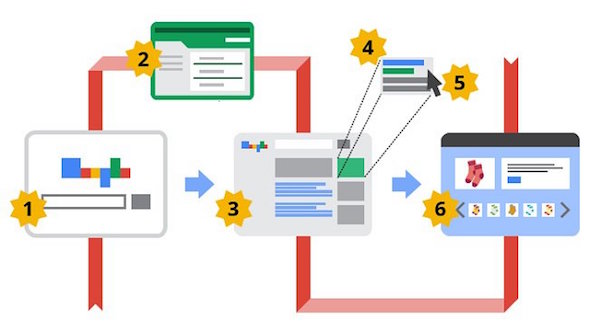
support.google.com
Google Search ads
These are the basic ads by Google. Users search for a term and they get paid suggestions on top and at the bottom of their search results page, optimized for this term. They integrate with Google Maps and Google Shopping as well. Product Listing Ads (PLAs) are a variation that includes details like brand, price, and so on for faster shopping experience (created in your Google Merchant Center account).
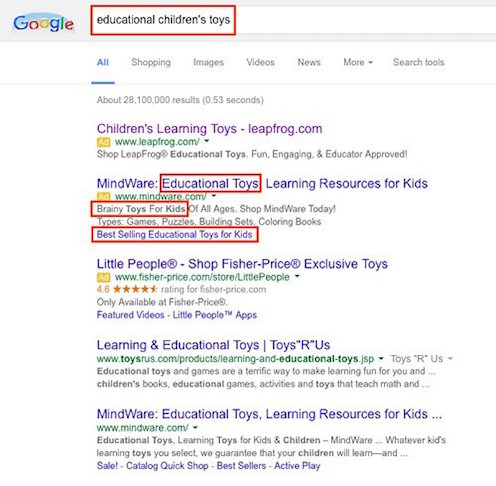
pagewiz.com
Google Display ads
Google contracts websites for its display network and places contextual banners on them. They can feature text, images or video. They can also work as Remarketing ads, meaning they use user browsing history and “follow” them around the web, promoting a certain product, for example, that users viewed earlier.
GSP (Google Sponsored Promotion)
These are the Gmail promotion ads. They work by detecting chosen keywords in user’s mailbox and sending them relevant promotional emails. One such example is finding subscribers to a competitor’s newsletter and sending them targeted messages. Here are a few tips on starting using GSP for your business.

stateofdigital.com
How to measure Google AdWords’ effectiveness as an acquisition channel?
When paying for traffic, it’s important to keep the cost in control because it’s still the top of the funnel. All these types of ads are paid per click and one rule of thumb is not to take the price quotes by Google for granted. Usually, it’s much cheaper. Certified AdWords experts say it takes about 5 days to see the real price of your keywords.
You can pay per click, per thousand viewable impressions, per acquisition, or per view. PPC or pay-per-click is the most popular one – it gives you, at least, the security that people expressed some interest in your offering.
There are countless resources out there how to optimize your spending but that’s a whole another blog post.
The importance of paid ads in relation to acquisition is in the ROI.
In some niches (for some very competitive keywords) the cost is higher than the average lifetime value of the customers so it’s pointless to rely on this acquisition method.
For example, if the keyword “handmade earrings” costs you $25 per click and you sell a pair of earrings for $5 (what ALTV can you expect on such items? certainly not $1000), chances are you’re actually losing money on customers who came through this keyword.
Naturally, you’ll have to test lots and lots of keywords and messages to match the price you’re willing to pay per every acquisition.
E-commerce Acquisition through SEO and Content Marketing
You know you have to optimize for search to stand any chance of being discovered. As the founder of Nic Harry, a luxury sock online company, put it, “
“Roads need to be built, people need to be told, marketing executed and customers hunted.”
Make it easy for people to find you and your products. Connect yourself with all the important words that say what you do, what you sell and who it is for – that’s optimization that gives value. Otherwise, you’re just wasting money battling for generic keywords like “clothes” when you actually sell maternity clothes and nursing bras.
Be specific, narrow down your niche – it will both give you better leads who are looking for your products, not just clothes. Create your whole copy and content around related keywords that draw in your target group and don’t mislead the rest. This way, you’re providing value (making it clear what you do) and optimizing for search.
As they said on Bootstrapping Ecommerce:
„SEO is crucial because it is free, qualified traffic coming to your website. You don’t need to pay to be found in Google. You just have to provide helpful, valuable, and relevant content that answers the questions that people are asking.“ [check out the rest of the article, too, it’s packed with useful info on the topic]
Skipping good SEO might result in high bounce rates for your website because visitors would expect one thing and find another.
What about content then? It doesn’t necessarily mean you need a blog, but more text (in which you use relevant terms) gives you a better chance to get indexed in the right niche. For example, the more we write about e-commerce analytics, the better Google understands we’re in that niche and our rank on that term improves.
Why content works for acquisition
Just like with social media – you provide value first and sell after. Visitors will come to find information, inspiration, whatever that’s remotely related somehow to your product. Need examples? We compiled ideas about content you can easily create for different products.
Sometimes content can even help your visitors understand your product better or discover additional uses. Not Another Bill, an artsy online shop for funky stationery and gifts, has a blog about art, DIY projects, interiors, and other beautiful and inspiring things. Chances are, visitors will find their articles first and then convert to customers when they see the products reflect the same aesthetics.
Ready now? We’d like to start you with this ultra-comprehensive guide that covers everything about SEO – from keyword research to schema markup and link building.
Then, you can go over your SEO efforts again and compare to the Best Practices for Ecommerce Product Pages.
If you feel confident enough to dive deeper, check out these tips on different SEO tactics that can help you outrank Amazon.
Don’t forget to add tracking UTM codes to you content so you see in your analytics software exactly through what links you acquired visitors. Then analyze the best-performing ones and focus on creating more like them – more content of the same type, for instance.
Acquisition is just the first step in the AARRR metrics funnel. The tactics you use to enhance it influence the potential for conversion because acquisition is effective only when it brings in the right people to the top of the funnel. Otherwise, you’re wasting money on traffic that doesn’t convert.
Got hooked on the beauty of the AARRR metrics? Check out the next article in the series – on activating users.
AARRR Acquisition case study: How a fresh juice ecommerce business acquires customers?
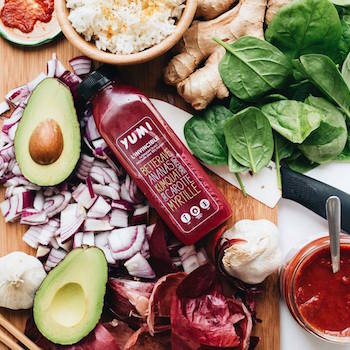 Acquisition is the main focus of emerging companies, we talked to the founder of Yumi, Louis de Bentzmann, who shares with us what they particularly do to grow their customer base. The company operates a fresh vegetable juice delivery business out of France.
Acquisition is the main focus of emerging companies, we talked to the founder of Yumi, Louis de Bentzmann, who shares with us what they particularly do to grow their customer base. The company operates a fresh vegetable juice delivery business out of France. 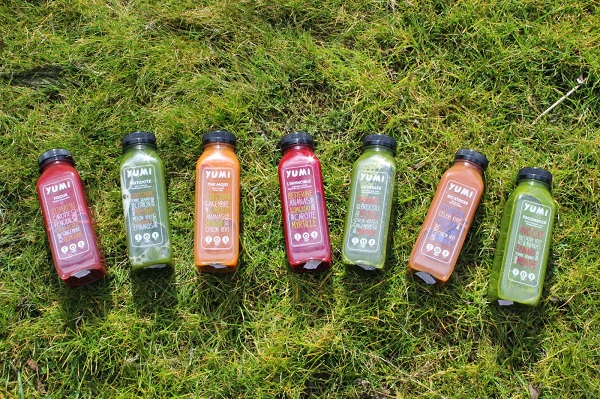
They use cold extraction to make the juice and High-Pressure Processing technology to preserve it.
Ideal customers
It turned out different age groups were interested in healthy drinks and would prefer someone else to make them.
25 to 35 year-olds are really health-conscious but don’t want to bother preparing fresh juices themselves.
35-45 year-olds feel the need of a healthier lifestyle, but have no time to do it.
Elderly people are keen on the idea, too, because they realize good food can help with health conditions they suffer from.
So it appears the target audience is pretty broad and it allowed them to start off strong even as a local business.
One smart thing they did was to offer all juices in bundles, not individually – this way, customers order for a few days ahead and the team can cope with deliveries.
Acquisition channels
In our guide article to Acquisition, we explored social media, display advertising, SEO, and content as suitable acquisition channels for e-commerce.
Although Louis admits that almost half of the traffic to the site comes from direct search in Google – that means awesome brand recognition, they’re putting efforts in other well-planned channels:
- influencer links
- referral programa sample. It was met with huge interest and resulted in plenty of positive reviews to spur attention.
- social media
- partner email campaigns
Let’s look at them one by one.
Influencer links
The company managed to establish relationships with very influential bloggers in its niche.
Of course, the product helped because it’s easy to be sent out as a sample. It was met with huge interest and resulted in plenty of positive reviews to spur attention.
Nutritionists
Louis brought professional nutritionists and health coaches on board as consultants to help concoct the blends.
They sound a little strange at first – mixing pineapple, turmeric, mint and fennel, for example – but that’s exactly what he was after – exciting combinations that do miracles to the body.
Working with specialists helped the company establish itself as a brand that really knows good nutrition and cares for the quality of its products.
Those professionals were also able to spread the word about the new product among their clients and this type of “affiliate program” brings good traffic to their site.
Referral program
Relying on the like-mindedness of people and their friends, the company has a strong incentive: a €7 reward for every new customer brought in.
Louis is very satisfied with the results it has been yielding so far and they plan on keeping it.
Offline sales
As interest grew, the company decided to make the juices available at physical locations too. They’ve partnered with about 30 health stores so far and plan on expanding the distribution network as they launch a new product.
How offline sales help the online?
Easy – offline, people buy one or two bottles of juices spontaneously because they need a fresh fix on the go. They try it, they like it and order a week’s supply online.
Social Media
The product itself works great in social – it’s hip, bright-colored and niche. It appeals to the open-minded public that’s well connected online. It’s no surprise they’re killing it on Facebook and Instagram.
On the latter, their community is “super engaged and growing really fast”, according to Louis. It’s a great source of traffic because it gives the right platform to the right people who are genuinely interested in Yumi.
They are trying to develop the Facebook community to the same level through Facebook ads.
Partner Email Campaigns
Louis also mentioned that they participate in email campaigns together with other partners. Those campaigns rely on an external community and are often paid (when the partner is an important influencer).
Have they abandoned any acquisition channels?
Sure! Google AdWords, despite being top-of-mind, didn’t work out for them. Louis says vegetable juices are hard to promote because people search for recipes mostly and would not click on the ads.
His assumption is that it’s not a popular product people would immediately want to buy but rather try to make first. At least, the brand gets a ton of organic search traffic!
How do they evaluate acquisition channels?
The team has set strict KPIs for each channel’s effectiveness. Here’s what they measure.
Overall traffic to website: Unique Visits [set a monthly goal based on historical data]
Per channel: ratio = acquisition cost to revenue
Facebook especially: by cost per purchase
Affiliate partners: by cost to traffic generated
Email campaigns: by conversions
By the KPIs set, it’s clear Yumi is focusing on growth and no frills are yet in their strategy. They calculate the possible acquisition cost based on the Average Lifetime Value of their customers.
Such a detailed analysis would be impossible without the proper analytics tool that breaks down traffic and conversions by channel.
Yumi may be a young company, but they have a firm strategy in place – they only focus and invest in acquisition channels that have proved their worth for their particular business. This, again, comes to show that eCommerce entrepreneurs should learn from others but test what works for them and not spread too thin.
Read the second part of Louis’ interview where he talks about retention, cart abandonment, and customer experience.
Try Metrilo for free
traffic, sales, product stats, retention and more
Build and grow your ecommerce brand
Metrilo’s mission is to help you build your ecommerce brand and win your place in the customer’s heart. We share what we learn from our daily work with product innovators and founders here. Subscribe to our weekly newsletter to get the freshest lessons and conquer your niche.
We promise, no spam.
Thank you for subscribing!
See you soon :-)
